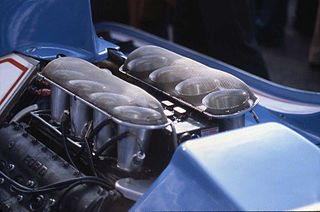
The DFV is an internal combustion engine that was originally produced by Cosworth for Formula One motor racing. The name is an abbreviation of Double Four Valve, the engine being a V8 development of the earlier four-cylinder FVA, which had four valves per cylinder.

Group C was a category of sports car racing introduced by the FIA in 1982 and continuing until 1993, with Group A for touring cars and Group B for GTs.

The Mirage Lightweight Racing Car was a family of race cars built by J.W. Automotive Engineereing (JWAE) at Slough in England, initially to compete in international sports car races in the colours of the Gulf Oil Corporation.

Spice Engineering was a British racing team founded by driver Gordon Spice with Raymond Bellm in the early 1980s, later becoming a successful sports car constructor in 1986. They competed in the World Sportscar Championship in Europe as well as the IMSA GT Championship in North America, at times partnering with major manufacturers such as General Motors and Honda as well as race engine manufacturer Comptech.

The 1984 Sandown 1000 was an endurance motor race staged at the Sandown Raceway in Victoria, Australia on 2 December 1984. It was the eleventh and final round of the 1984 FIA World Endurance Championship and was the first FIA World Championship race to be held in Australia. It was to be the first of a three-year contract to race at Sandown, though the final two years would be cancelled.
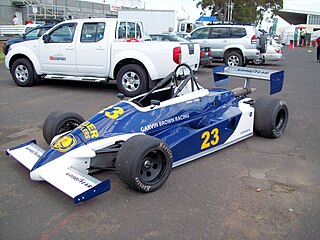
Tiga Race Cars Ltd. was a British auto racing constructor and team. The company was founded in 1974 by two former Formula 1 drivers, Australian Tim Schenken and New Zealander Howden Ganley. The company's name was formed by the first two letters of Tim and Ganley. Tiga constructed racing cars for various forms of open wheel racing and sports car racing, ranging from Formula Ford to the World Sportscar Championship.
Sean Walker is a British former racing driver. He stopped racing in 2013. His father Ian Walker (1926–2008) was noted as the "Doyen of British Motorsport" was a driver, engineer and designer/modifier of race cars particularly Lotus. Ian Walker's cars were driven by famous drivers such as Jim Clark, Graham Hill and Peter Arundell.
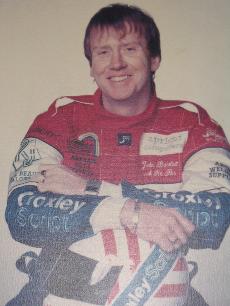
John Bartlett is best known as a former WSCC race driver and team owner in the 1980's. He first started racing FF1600 cars in 1979 before moving into sports prototypes.
John Schneider is a former American sports car racing driver.

The Spice SE88C is a Group C2 sports prototype race car, designed, developed, and built by British manufacturer, Spice Engineering, for sports car racing in the World Sportscar Championship, in 1988.
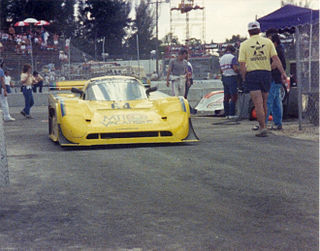
The Spice SE89C is a Group C1 and Group C2 sports prototype race car, designed, developed, and built by British manufacturer, Spice Engineering, for sports car racing in the World Sportscar Championship and IMSA GTP Championship, in 1989.

Robin Donovan is a British former racing driver. He is best known for competing in 14 editions of the Le Mans 24 hours race; his best result there being 6th overall, 3rd in class (LMP1) and 1st privateer home driving with 5 x Le Mans winner Derek Bell MBE and Daytona 24 hours winner Jurgen Lassig in 1994 with the Gulf Racing entered and sponsored Kremer Porsche K8.
The Tiga GC84, also known as the Tiga GC284, is a sports prototype race car, designed, developed, and built by British manufacturer Tiga Race Cars, for sports car racing, conforming to the Group C1/C2 rules and regulations, in 1984.

The March 74S is a Group 5 prototype race car, designed, developed and built by British manufacturer March Engineering, for sports car racing, in 1974.

The Spice SE90C is a Group C1 and Group C2 sports prototype race car, designed, developed, and built by British manufacturer, Spice Engineering, for sports car racing in the World Sportscar Championship and IMSA GTP Championship, in 1990.

The Tiga GC287 is a sports prototype race car, designed, developed, and built by British manufacturer Tiga Race Cars, for sports car racing, conforming to the Group C2 rules and regulations, in 1987.
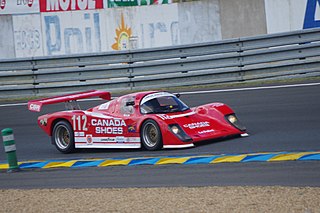
The Tiga GC286 is a sports prototype race car, designed, developed, and built by British manufacturer Tiga Race Cars, for sports car racing, conforming to the Group C2 rules and regulations, in 1986.
The Tiga GC285, also known as the Tiga GC85, is a sports prototype race car, designed, developed, and built by British manufacturer Tiga Race Cars, for sports car racing, conforming to the Group C2 rules and regulations, in 1985.
The 'Tiga GC83 is a sports prototype race car, designed, developed, and built by British manufacturer Tiga Race Cars, for sports car racing, conforming to the Group C1/C2 rules and regulations, in 1983.

The Tiga GC288 is a sports prototype race car, designed, developed, and built by British manufacturer Tiga Race Cars, for sports car racing, conforming to the Group C2/IMSA GTP Lights rules and regulations, in 1988.















